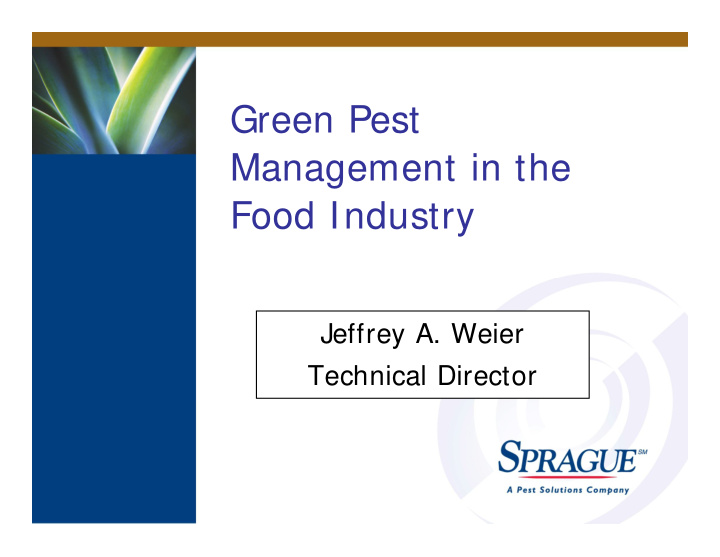



Green Pest Management in the Food Industry Presented by Jeffrey A. Weier Technical Director A Copesan Pest Services Partner
A Copesan Pest Services Partner
What is Green? Why Green? A Copesan Pest Services Partner
What is Green? Sustainable Practices Efficient Resource Use Do not Degrade the Environment You Environmental “Foot Print” People have different levels of “Greenness” A Copesan Pest Services Partner
Why Green Our customers are asking for it It doesn’t matter if we agree with it or believe in it It is permeating every aspect of our lives It has been taught in our schools for the last 30+ years Being Green has merit A Copesan Pest Services Partner
Opportunities Exist Within your business With the services you provide A Copesan Pest Services Partner
Within Your Business A Copesan Pest Services Partner
Carbon Centered Ideas Carbon Footprint : An estimate of how much carbon dioxide an entity (be it person, family or building) produces and releases into the atmosphere Carbon Neutral : Reducing energy use and compensating for the amount of carbon dioxide an entity generates through either obtaining energy from renewable sources or offsetting. Carbon Offsets : Credits earned for activities that help balance CO2 emissions, such as planting trees. They can also be bought from a provider who uses the money to plant trees, generate renewable energy or conserve energy. A Copesan Pest Services Partner
Carbon Footprint Fuel efficient vehicles Efficient routing Energy efficient lighting Types of fixtures Lighting control, motion sensors A Copesan Pest Services Partner
Sustainable Energy A Copesan Pest Services Partner
Recycle Recycle cans, bottles Recycle paper A Copesan Pest Services Partner
Reducing Resource Use Using electronic data collection and reporting to reduce paper use Using paper with recycled content Water use; low flow toilets etc. A Copesan Pest Services Partner
Pest Control Products and Services A Copesan Pest Services Partner
Not Green? A Copesan Pest Services Partner
Green Pest Management Based on IPM Documentation is Critical Education Necessary Begins with Inspection Physical Control measures first Sanitation Building Maintenance Exclusion Trapping Removal of Pests If pesticides are needed, use the least toxic, Selective Solution A Copesan Pest Services Partner
Selective Solutions Those methods that, as much as possible, impact the target pest, effectively eliminate it and affect nothing else A Copesan Pest Services Partner
Achieving Selective Solutions Identify and remove the conditions that allow pests to survive Always seek to apply permanent rather than temporary solutions to pest issues Seek out the source Choose products and application methods that are effective and low risk (Least Toxic) Strive to reduce waste Give preference to materials and applications that are target specific A Copesan Pest Services Partner
Achieving Selective Solutions Make no “routine” applications No general surface applications Preventative applications generally not justified Work with product manufacturers committed to sustainability Must be effective! A Copesan Pest Services Partner
Practical Suggestions Baits, roaches , ants , flies, termites Non-toxic rodent bait for monitoring Boric acid, DE etc EPA reduced risk and exempt products Pheromones and mating disruption Heat and Cold Vacuum A Copesan Pest Services Partner
Non-Toxic Rodent Baits New ones contain Biomarker Can help determine the source of an infestation A Copesan Pest Services Partner
Least toxic Pesticides Diatomaceous Earth Spinosid Insect Growth Regulators Plant Oils A Copesan Pest Services Partner
Reduced Risk Pesticides Indoxacarb Dinotefuran Cholecalciferol Metapesticide A Copesan Pest Services Partner
Pheromones Attraction Repulsion Confusion A Copesan Pest Services Partner
A Copesan Pest Services Partner
MD Allure A Copesan Pest Services Partner
CideTrak IMM A Copesan Pest Services Partner
Exosex SP Tab A Copesan Pest Services Partner
Is Fumigation Green? Profume EcoFume Fumigation systems A Copesan Pest Services Partner
Green Standards and Certification Unlike Organic, no government programs exist Private organizations are currently filling the void A Copesan Pest Services Partner
Green Certification Programs GreenShield Green Pro LEED Certification A Copesan Pest Services Partner
Green Shield Green Shield Certified is an independent, non-profit certification program that promotes practitioners of effective, prevention-based pest control while minimizing the need to use pesticides. Because our approach addresses the underlying cause of pest problems, it is more effective than conventional spray-intensive services. Green Shield Certification is available to qualifying pest control professionals and to buildings and facilities where our standards are attained. http://www.greenshieldcertified.org/ A Copesan Pest Services Partner
A Copesan Pest Services Partner
Green Pro Part of NPMA Quality Pro Certifies companies Management training Technician training Programs for specific accounts http://www.npmagreenpro.org/ A Copesan Pest Services Partner
LEED Leaders in Energy and Environmental Design A Copesan Pest Services Partner
LEED Certification The U.S. Green Building Council LEED is an internationally recognized green building certification system , providing third- party verification that a building or community was designed and built using strategies aimed at improving performance across all the metrics that matter most: energy savings, water efficiency, CO2 emissions reduction, improved indoor environmental quality, and stewardship of resources and sensitivity to their impacts. http://www.usgbc.org/ A Copesan Pest Services Partner
Pest Control and LEED Buildings are rated on a point system Pest Control can gain two points for the building Credits for IPM in two areas, Sustainable sites and Indoor air quality A Copesan Pest Services Partner
Questions? A Copesan Pest Services Partner
Recommend
More recommend